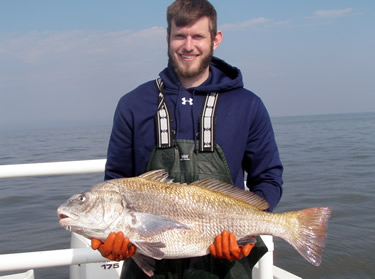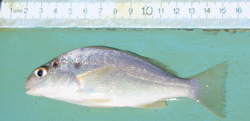  |
Drum Fish: A Profile |
|
by Joshua Freeman, Hourly Fisheries Technician
Bureau of Marine Fisheries
August 22, 2018
This profile highlights the key aspects and different species of drum fish that inhabit the waters surrounding New Jersey. Drums consist of fish in the family of Sciaenidae, categorized by the throbbing or drumming sound they emit. This large family consist of about 275 species in about 70 genera. Suitable habitat for drum fish ranges from marine to fresh water, from tropical to temperate. Most are commonly found in estuarine settings, but they can occur in rocky reef areas and over continental shelves. The drum fish is mostly predatorial, actively seeking out prey.
|
What makes a fish a drum fish?
Most drum species can produce a repetitive drumming sound. The drumming, croaking, or throbbing sound heard is produced by muscles vibrating against the species' swim bladder. These muscles are called sonic muscle fibers. The muscles run horizontally along the body of the fish around the swim bladder. The swim bladder acts as an amplifier allowing the vibrations to resonate outward, producing the sound commonly associated with drums. This sound is especially evident during the mating season.
Anatomical features of Sciaenids include long dorsal fins which reach virtually to the caudal (tail) fin. The fin is also split, but rarely separated completely, into two portions by a notching between the spiny and soft rayed portions of the dorsal fin. The anal fin consists of 1 to 2 weak spines, unlike the dorsal fin. Many of the species have a rounded or pointed caudal fin.
Sound of the Drum Fish (YouTube)
|

Hourly employee Anthony DellaVecchia with a 33", 22-pound male black drum caught in the 2015 Delaware Bay Striped Bass Tagging Survey.
Click to enlarge
|
Species found in New Jersey waters.
Several members of the drum family can be found in the waters surrounding New Jersey. A few of the more common species found are black drum, Atlantic croaker, spot, perch, and weakfish.
The black drum is the largest species of Sciaenidea, ranging in size from 5 to 30 pounds, but it is not uncommon for some fish to exceed 90 pounds (the state record, caught in Delaware Bay in 2008, weighed 109 pounds!). Adult black drum are found to be a blackish or grayish color, but juvenile fish have very distinctive dark stripes over a grey body. This species, being a bottom feeder, has a mouth with a downward orientation and a strong jaw with rounded teeth used to crush mollusk, crab, shrimp and a variety of aquatic vegetation.
|
Atlantic croaker are about 12 inches in length, weighing from a half pound to two pounds on average. Adult croaker have a silvering with pinkish casting for coloring; older fish have a brassy color with vertical dark stripes, and juvenile fish are silver and iridescent. A noticeable characteristic of croaker is the three to five barbells below the chin. These whiskers are used to locate food along the sea floor.
|

Click to enlarge
|
|
The spot is a commonly used bait fish. Its name comes from the predominant spot located just behind the gills. Spot primarily feed on organic detritus, small crustaceans, and a variety of invertebrates. This species primarily inhabits a range of marine environments, especially areas of brackish waters with sand or mud bottoms, but migrates to deeper waters during times of spawning.
|

Click to enlarge
|
|
Two types of perch found in New Jersey are yellow and silver perch. Yellow perch, unlike its cousins, is found in fresh water habitats. Yellow perch have a yellow to brass coloring with distinct five to nine olive green vertical bars with a triangle shape. Adult fish range in size of four to 11 inches, but have been found to exceed these limits. Their food sources are small invertebrates, fish eggs/larvae, crayfish, shrimp, and small fish. Their cousin, the silver perch is relatively similar in size, rarely exceeding nine inches. This perch has a silvery green coloring.
|

Click to enlarge

Click to enlarge
|
|
The name weakfish comes from this species' weak mouths - often after setting the hook it rips free due to their weak mouth muscles. Weakfish are sometimes referred to as sea trout, yet are not in any way related to trout. These fish are found along most of the east coast of the Atlantic, from Nova Scotia to northern Florida. They prey on a wide variety of food sources, anything from small schooling fish, assorted crabs, shrimp, and even larger zooplankton. The appearance of the weakfish is a slender body with colors of a light brown with a green tinge from head to tail, with the sides having a faint silver look with dusky specks. The common size ranges from 12 to 18 inches, but like many species can be found to exceed these limits.
|

Click to enlarge
|
Catching Drum Fish
For many anglers, drum fish are an exciting fish to target or catch incidentally. Drum fish are likely to be caught by anyone who is bottom fishing either by boat or land with a high low or sweeper rig since most of the drum species are actively seeking out prey on or near the bottom. A wide variety of bait can be used, including crab, squid, clam, and shrimp. A medium rod and reel should do the trick with twenty-pound test for line, unless targeting fish over thirty pounds in which case a stronger rod, reel, and line may be required.
To Sum It Up
The drum fish family is a very unique group because of their ability to croak, a sound that is produced by the muscles around the swim blander expanding and contracting. Outside of New Jersey waters, a considerably larger group consisting of about 275 species ranging in 70 different genera can be found in environments including fresh, salt, and brackish waters. Their sizes can range from a fish of 11 to 12 inches in length to ones weighing more than 50 pounds. Black drum, Atlantic croaker, spot, yellow perch, silver perch, and weakfish are the most commonly found and fished for species in New Jersey's waters, but are just a few of the many varieties found worldwide.
|






